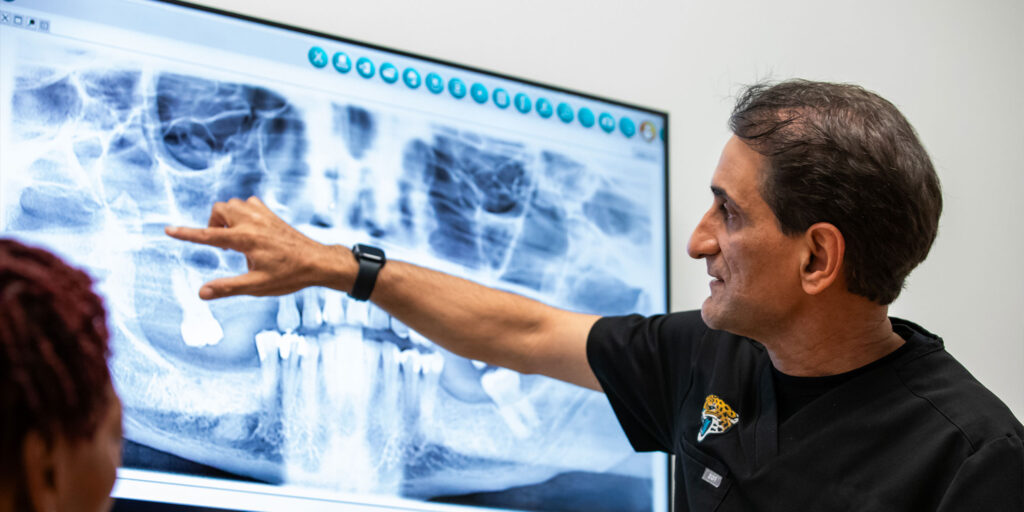

Broad Surgical Expertise
At ASAP Dental Care, we treat a wide variety of common and complex dental issues. No matter what you’re experiencing, we have the expertise to get you back to a happy, healthy, beautiful smile. As board-certified dentists, we have extensive, advanced training to provide care for dental and facial conditions. Rely on us for problems ranging from infected wisdom teeth that have to come out to replacement of missing teeth in Jacksonville, FL.
Even The Small Things Matter!
Impacted teeth are those that haven’t erupted fully through the gums, which can occur with stubborn baby teeth, wisdom teeth, and sometimes with permanent adult teeth. There are various reasons why adult teeth can have a difficult time erupting. Among the most common reasons are: higher than the normal number of teeth in the mouth, obstructive growths, and overcrowding from surrounding teeth. Impacted teeth can cause a number of problems for the patient starting at an early age. If these teeth are not able to come in fully, the child may have difficulty eating normally, as well as pain and tooth misalignment. In many other cases, symptoms may not appear until an X-ray presents the issue. We can offer a few options to resolve impacted teeth, including working in collaboration with an orthodontist to guide the tooth to the proper placement. In the case of wisdom teeth, we often recommend extraction.
Commonly known as “wisdom teeth,” third molars typically emerge during the late teenage years or early 20s, and have the potential to cause a variety of oral health problems. Almost 90% of people have or have had at least one impacted wisdom tooth, which indicates that there isn’t sufficient space for the teeth to erupt into a normal position. Their location in the very back of the mouth makes them hard to clean and therefore more prone to decay, infection, gum disease, pain, and even the development of cysts or tumors in the surrounding tissues! They can also throw neighboring healthy teeth out of alignment.
Oftentimes, wisdom teeth are located in close proximity to nerves, sinus cavities and other teeth, so it’s important that you have a skilled expert remove the teeth if they become impacted. As board-certified dentists, we’re exceptionally qualified to remove your wisdom teeth while maintaining your comfort and safety at all times.
Teeth can become broken or infected for several reasons, including trauma and decay. Bacterial buildup due to poor dental hygiene is often the cause of dental infections. Sometimes repairs, medications, or a combination of both enable our doctors to save your tooth. In such cases, we thoroughly evaluate your teeth to determine what course of treatment is best suited to your specific issue. When damage or decay is extensive, some teeth cannot be rehabilitated through treatment. Though we do our utmost to preserve your natural teeth, extraction may be our only option.
The extraction process for most teeth is fairly straightforward. After making you comfortable with anesthesia, we grip the tooth firmly with a pair of forceps and carefully pull it loose from the socket. Unless it’s a wisdom tooth, a tooth should be replaced once it’s removed, in order to restore the function and esthetics of your smile, as well as to protect your jaw from deterioration. Dental implants are the best overall tooth replacement option, not just in terms of function and esthetics, but also for long-lasting performance.
Missing teeth can not only limit your ability to eat, speak and smile comfortably, they may have deeper implications beyond simple chewing function and smile esthetics. Teeth rely on each other for support. When one is missing, the teeth on either side of the gap can shift out of alignment, eventually requiring orthodontic treatment. Further, the absence of tooth roots in the jawbone can cause the jawbone to begin receding, leading to further tooth loss and giving your face an unhealthy, sunken, and even prematurely aged appearance!
Dental implants, recognized as today’s “gold standard” for tooth replacement, can prevent you from experiencing any of those issues. If you follow a tooth extraction or trauma-related tooth loss with dental implant placement, you can continue eating the foods you love, speak and smile without embarrassment, and even significantly boost your self-confidence. All this can be yours, since nothing looks more authentic or lasts longer than our dental implants in Jacksonville, FL. Even if you’ve already begun to suffer bone loss, our team of board-certified dentists can reverse it through bone grafting before placing your dental implants.
Your jawbone relies on the stimulation of tooth roots and the regular sensation of chewing to keep it healthy. With tooth loss, the bone itself can start to deteriorate unless those missing teeth are replaced quickly. This bone loss has many short-term and long-term consequences. You can end up losing more teeth through a “domino effect” of tooth loss. Your facial features can sink, and your distinctive appearance can be replaced by an aged, unhealthy look that you won’t want or even recognize.
Fortunately, our team of board-certified dentists is extensively trained in treating even the most severe cases of bone loss. We’re able to give new teeth and a new life to patients who may otherwise have to settle for living without teeth. Beyond single and full mouth dental implant solutions with bone grafting treatment plans, we also offer zygomatic dental implants. These specialized implants can help patients who have lost a significant amount of bone. Placed in specialized facial bone beyond the jawbone, zygomatic implants are precisely placed for lasting security.
Jaw misalignment—when your top and bottom rows of teeth don’t naturally fit together as you bite down—can cause you a host of problems, including headaches, facial pain and ringing in the ears. In the most severe instances, it can create difficulties while eating, speaking, breathing and sleeping. On top of this, any asymmetry can compromise your facial esthetics. Your face may be noticeably uneven, making you feel self-conscious about your appearance.
While jaw misalignment can sometimes be alleviated by orthodontia or the use of a mouthguard, severe misalignments may require surgery. Whether your jaws are out of alignment or your facial features are uneven, our skilled and experienced team can correct those issues and allow you to enjoy a more comfortable and confident life. As dentists, we’re qualified to effectively treat complex and even medically compromised cases through jaw surgery.
The presence of cysts or tumors on your face and in your jaws can be frightening, and can also cause you significant discomfort. Sometimes they’re not as bad as they seem, but you won’t know until they’ve been professionally assessed. The best way to find out is to have an evaluation done by our team. We can diagnose the issue through advanced imaging or through a biopsy, during which we remove a portion of the growth for lab analysis.
Based on our determinations, we may recommend jaw surgery, medical therapy or a combination of both. Surgery may involve the removal of the cyst or tumor, as well as portions of the jawbone, teeth and soft tissue. As highly trained dentists, we’re acknowledged experts in these types of procedures, and as a follow-up to surgery, we can provide all the necessary treatments (such as bone grafting to restore your jawbone and dental implants to replace the function and beauty of your missing teeth) to allow you to live a normal, comfortable life!
We Can Fix The Most Complex Dental Problems.
I understand the information disclosed in this form may be subject to re-disclosure and may no longer be protected by HIPAA privacy regulations and the HITECH Act.
Jacksonville, FL
- 103rd St
- Dunn Ave
- Bonneval Rd
- Atlantic Blvd
- San Jose Blvd
Lake City, FL
- SW Main Blvd
Orange Park, FL
- Blanding Blvd
Jasper, FL
- 1st Ave SE
Crescent City, FL
- N. Summit St
